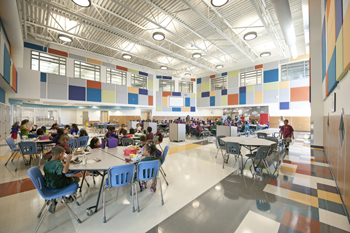DLR Group Study Demonstrates Benefits of Green School Design
 FORT COLLINS, Colo. — In partnership with the Institute for the Built Environment (IBE) at Colorado State University, Seattle-based DLR Group recently released a study on the impacts of green school design on its occupants and long-term building performance.
FORT COLLINS, Colo. — In partnership with the Institute for the Built Environment (IBE) at Colorado State University, Seattle-based DLR Group recently released a study on the impacts of green school design on its occupants and long-term building performance.
In the report titled “Linking Performance & Experience – An Analysis of Green Schools,” major findings include positive impact on student health, behavior and achievement. The study also establishes DLR Group’s firm commitment to evaluating finished projects and securing quality operations.
“We’ve come to the conclusion at DLR Group that design and the project aren’t finished at the grand opening date,” said Jim French, AIA, senior principal and national K-12 practice leader. “We firmly believe that it continues on and past the time that the building is finished and through the time the client is operating it. We try to monitor and work with our clients afterwards to ensure that [the buildings] are in fact running the way they were designed.”
IBE surveyed 12 PK-8 schools in eight states and measured each school’s energy use against Architecture 2030 benchmarks, which aim to reduce greenhouse gas emissions in the planning, designing and construction of buildings. The study also measures the cost of construction compared to median school construction in the region, the health and well-being of occupants, and overall operations and maintenance of the school facilities.
The study, initiated by DLR Group, was beneficial to the firm in order to have evidence that their efforts in sustainable design are reaping major benefits for the buildings’ occupants but also demonstrates that green schools do not necessarily come at a higher cost.
“For us it’s nice to have tangible information for our clients because with school districts I think there’s this perception that if you begin talking about a green school you’re instantaneously going to talk about more costs upfront to build that building,” French said.
The study found that 60 percent of the sites sampled from DLR Group were constructed below the regional median cost for schools built in the same year. Additionally, the green buildings’ efficiency required much less maintenance and therefore operated at a lesser cost.
“We recognize that the operation of a building over its life outweighs construction,” said Rod Oathout, LEED AP, principal and regional engineering leader at DLR Group.
In interviews with facility managers at each school, all managers indicated that if their district builds another school they would opt for a green, high-performing school.
According to the study, 85 percent of respondents reported positive impacts to their health and productivity while 71 percent perceived a positive impact on student health and behavior. Approximately 87 percent reported a positive impact to student health. Overall, schools designed by DLR Group report on average one day less of absenteeism in students, according to French.
Stephanie Barr, research associate and green schools specialist at IBE, authored the study. Barr said the atmosphere of a green school promotes student recognition of the community’s commitment to education.
“They’re appreciative of the place that they’ve been granted,” Barr said. “I think this is true when they see that their community values them and values their learning because they built them this beautiful school.”
For Oathout, the study’s optimism to share green elements as well as the positive perceptions of the workspaces provided by DLR Group was one of the study’s greatest findings.
“The great examples of green schools are ones that perform well from those energy metrics and natural resource metrics but also use the systems in the building as a teaching tool for the students and the curriculum,” he said. “Anybody can build a box and make it perform great energy-wise, but to make an inspiring space to work in for the instructors and to learn in for the students, that’s really what we’re after.”
In this podcast with Barr, the author of the study discusses the importance of conducting studies of school architecture and its effect on the building’s occupants.
